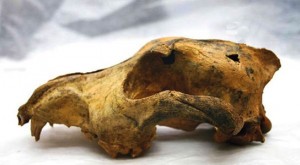Researchers find a 33,000 year old domesticated dog skull in Siberia
Monday, January 30th, 2012 6:11:37 by Taimoor Tariq
An ancient domesticated do skull was found in a Razboinichya cave in the Altai Mountains of Siberia. Using an accelerator mass spectrometry and radiocarbon dating, University of Arizona physicist Greg Hodgins was able to determine the skull to be 33,000
years old. This predates the Last Glacial Maximum, which occurred between about 26,000 and 19,000 years ago.
This serves as an oldest known evidence of dog domestication and also indicates that modern dogs actually descended from multiple ancestors. This discovery also indicates that domestications might have occurred repeatedly in various geographical locations
rather than with a single domestic event.
In plain words, man’s best friends might have originated from more than just one ancestor which is contrary to what some DNA evidence indicated previously.
“Both the Belgian find and the Siberian find are domesticated species based on morphological characteristics,” said Greg Hodgins, a researcher at the University of Arizona’s Accelerator Mass Spectrometry Laboratory and co-author of the study that reports
the find.
“Essentially, wolves have long thin snouts and their teeth are not crowded, and domestication results in this shortening of the snout and widening of the jaws and crowding of the teeth.”
The Altai Mountain skull is extraordinarily well preserved, said Hodgins, enabling scientists to make multiple measurements of the skull, teeth and mandibles that might not be possible on less well-preserved remains. “The argument that it is domesticated
is pretty solid,” said Hodgins. “What’s interesting is that it doesn’t appear to be an ancestor of modern dogs.”
The UA’s Accelerator Mass Spectrometry Laboratory used radiocarbon dating to determine the age of the Siberian skull.
Radioactive carbon, or carbon-14, is one of three carbon isotopes. Along with naturally occurring carbon dioxide, carbon-14 reaches the surface of the Earth by atmospheric circulation, where plants absorb it into their tissues through photosynthesis.
Animals and humans take in carbon-14 by ingesting plants or other animals that have eaten plants. “Carbon-14 makes it into all organic molecules,” said Hodgins. “It’s in all living things.”
“We believe that carbon-14 production is essentially constant over time,” said Hodgins. “So the amount of carbon-14 present in living organisms in the past was similar to the levels in living organisms today. When an animal or plant dies, the amount of carbon-14
in its remains drops at a predictable rate, called the radioactive half-life. The half-life of radiocarbon is 5,730 years.”
“People from all over the world send our laboratory samples of organic material that they have dug out of the ground and we measure how much carbon-14 is left in them. Based on that measurement, and knowing the radiocarbon half-life, we calculate how much
time must have passed since the samples had the same amount of carbon-14 as plants and animals living today.”
The Siberian skull predates the Last Glacial Maximum which occurred about 26000 to 19000 years ago when the ice sheets of Earth’s last age reached their greatest extent. This also means that neither the Belgian nor the Siberian lineages appear to have survived
the Glacial Maximum.
However, the skull structures show that domestication might have occurred repeated throughout early human history at many geographical locations.
Tags: DNA, dog, greg hodgins, last glacial maximum, Mass Spectrometry Laboratory, Razboinichya, siberia, university of arizonaShort URL: https://www.newspakistan.pk/?p=11129

















